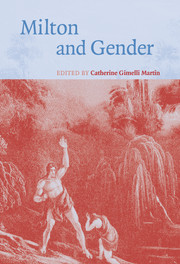Book contents
- Frontmatter
- Contents
- List of illustrations
- Notes on contributors
- Acknowledgments
- Abbreviations
- Introduction: Milton's gendered subjects
- PART I MASCULINITY, DIVORCE, AND MISOGYNY IN MILTON'S PROSE
- PART II THE GENDERED SUBJECTS OF MILTON'S MAJOR POEMS
- PART III GENDERED SUBJECTIVITY IN MILTON'S LITERARY HISTORY
- 11 George Eliot as a “Miltonist”: marriage and Milton in Middlemarch
- 12 Saying it with flowers: Jane Giraud's ecofeminist Paradise Lost (1846)
- 13 Woolf's allusion to Comus in The Voyage Out
- Index
12 - Saying it with flowers: Jane Giraud's ecofeminist Paradise Lost (1846)
Published online by Cambridge University Press: 22 September 2009
- Frontmatter
- Contents
- List of illustrations
- Notes on contributors
- Acknowledgments
- Abbreviations
- Introduction: Milton's gendered subjects
- PART I MASCULINITY, DIVORCE, AND MISOGYNY IN MILTON'S PROSE
- PART II THE GENDERED SUBJECTS OF MILTON'S MAJOR POEMS
- PART III GENDERED SUBJECTIVITY IN MILTON'S LITERARY HISTORY
- 11 George Eliot as a “Miltonist”: marriage and Milton in Middlemarch
- 12 Saying it with flowers: Jane Giraud's ecofeminist Paradise Lost (1846)
- 13 Woolf's allusion to Comus in The Voyage Out
- Index
Summary
Were I, O God, in churchless lands remaining,
Far from all voice of teachers and divines,
My soul would find in Flowers of thy ordaining
Priests, sermons, shrines.
(Jane Giraud, frontispiece, The Floral Months of England)A single flower along the way also can contain the whole ecosystem.
(John Elder, Reading the Mountains of Home)John Milton's Paradise Lost is, after the Bible, the most widely illustrated book in European history. It is also, arguably if controversially, one of the earliest great feminist poems – a poem that, as Joseph Wittreich demonstrated in 1987, has given heart and hope to three centuries of women readers. Yet since 1688, although nearly 200 artists have tried to bring Milton's epic to visual life – among them such well-known figures as William Blake, Henry Fuseli, John Martin, and Gustav Doré – all but four of those artists have been men. Of the four woman artists who have responded in some way to the poem, three have worked during the twentieth century. American artist Carlotta Petrina (1901–97) produced a set of sixteen pencil drawings for a Limited Editions Club issue of Paradise Lost and Paradise Regained, which was published in 1936. Working at the same time, but with no knowledge of her American contemporary, Englishwoman Mary Elizabeth Groom (1903–58) produced a set of nineteen wood engravings for the Golden Cockerel Press's rare ten-book edition of Paradise Lost, published in honor of the coronation of King George and Queen Elizabeth in 1937.
- Type
- Chapter
- Information
- Milton and Gender , pp. 223 - 253Publisher: Cambridge University PressPrint publication year: 2005
- 1
- Cited by

